Advances in Enhancing the Photothermal Performance of Nanofluid-Based Direct Absorption Solar Collectors
Abstract
1. Introduction
2. Application of Nanofluids in Solar Radiation Direct Absorption
2.1. Oxide Nanomaterial-Based Nanofluid
2.2. Carbon/Nitrogen Nanomaterial-Based Nanofluid
2.3. Plasmonic Nanofluid
| Authors (Year) | Nanoparticle/Base Fluid | Nanoparticle Size | Remarks |
|---|---|---|---|
| Sharaf et al. (2019) [62] | Au/DI-water | 10 nm | Sixteen-month stability for citrate- (CIT-) and polyethylene glycol-coated (PEG-) gold nanofluids |
| Joseph et al. (2019) [66] | SiO2-Ag, CuO/water | 300 nm | An 82.82% solar-weighted absorption fraction for hybrid nanofluid (SiO2/Ag: 206.3 mg L−1, CuO: 864.7 mg−1, and SDS: 1996.2 mg−1) |
| Sreekumar et al. (2020) [51] | Antimony tin oxide- silver nanoparticle/DI-water | Less than 10 nm | A 98.90% solar-weighted absorptivity for 0.2 wt% nanofluid; A 63.5% thermal efficiency for nanofluid-seeded parabolic through direct absorption solar collector at a flow rate of 0.022 kgs−1 |
| Kumar et al. (2020) [47] | Au/DI-water | 40–45 nm | A 33% increase in optical efficiency of gold plasmonic nanofluid compared with DI water at 0.030 kgs−1 flow rate |
| Wen et al. (2021) [67] | TiN/ethylene glycol | 20 nm | A 99% solar absorption ratio for TiN nanofluid; An increase of 67.1% in solar-thermal conversion efficiency for TiN nanofluid compared with glycol ethanol |
| Mallah et al. (2022) [68] | Ag/water | 25–35 nm | An 85% collector efficiency for 0.94 ppm volume fraction of blended plasmonic nanofluid at irradiation of 949 Wm−2 |
2.4. Nanophase Change Slurry
2.5. Comparative Analysis
3. Opportunities and Challenges of Nanofluid Applications
3.1. Challenges
3.1.1. Environmental Hazards
3.1.2. Economic Barriers: Implementation Costs
3.1.3. Long-Term Stability Under Operational Conditions
3.1.4. Toxicity and Occupational Safety
3.1.5. Limitations of Current Nanofluid Models
3.2. Directions for Further Research
3.2.1. Life Cycle Assessment (LCA) of Nanofluids in Solar Systems
3.2.2. Research on Hybrid Nanofluids in Real-World Conditions
3.2.3. Development of Predictive Models for Nanofluids in DASCs
3.2.4. Optimization of Protective Coatings and Surfactants
3.2.5. Integration of DASCs with Other Renewable Energy Technologies
3.2.6. Modeling and Simulation of Nanofluid Behavior
4. Conclusions
- •
- Among common working fluids, the mixture of EG and water is considered the most suitable base fluid for anti-icing at night. While thermal oil shows high thermal conductivity, it is susceptible to thermal oxidation degradation under solar radiation. Conversely, water is the most widely used base fluid, and many reports have demonstrated the high photothermal conversion efficiency of water-based nanofluids.
- •
- The nanofluid concentration strongly affects the thermal efficiency of the collector. Increasing the nanoparticle concentration results in a higher extinction coefficient for the nanofluid, a higher collector outlet temperature, improved energy efficiency, and enhanced exergy efficiency of the system. However, the increase in nanoparticle concentration also results in larger heat loss to the ambient. A critical particle concentration range exists that achieves the optimal photothermal conversion performance.
- •
- The morphology of nanoparticles affects the extinction coefficient of nanofluids, with sharp-edged morphologies exhibiting excellent optical absorption characteristics.
- •
- Nanoparticle size has a slight effect on the extinction coefficient within a specified range of spectral bands.
- •
- In direct absorption solar collectors, the photothermal conversion efficiency can be ranked from highest to lowest in the order of metal nanofluids, carbon-based nanofluids, metal oxide nanofluids, and non-metal oxide nanofluids.
- •
- Multivariate nanofluids offer advantages in absorbing solar spectra. A single nanoparticle usually exhibits only one spectral absorption peak. The specific performance improvement depends on various factors, such as type, concentration, ratio, and morphology of nanoparticles.
- •
- Composite nanoparticles synthesized with multiple elements show high full-spectrum absorption performance. The optical absorption properties of nanofluids are not solely based on the direct addition of single particles, regardless of whether nanofluids are directly mixed or prepared by composite particles. The photonic superposition of local surface plasmon resonance, surface plasmon resonance propagation, and gap resonances at different wavelengths contributes to the difference in optical absorption performance.
- •
- Al2O3 and CuO are commonly used metal oxide nanoparticles for preparing nanofluids as heat-absorbing media in direct absorption solar collectors. The average thermal efficiency improvement typically falls in the range of 10% to 40%. CuO nanoparticles show a higher extinction coefficient compared to Al2O3 nanoparticles.
- •
- The thermomagnetic convection of magnetic nanofluids improved the utilization of non-sustainable solar energy. The photothermal conversion performance of magnetic nanofluids can be further enhanced through magnetic field induction, resulting in a 13% to 75% increase in convective heat transfer performance.
- •
- Carbon nanomaterials, such as carbon nanotubes and graphene, exhibit excellent optical absorption and thermal conduction properties, resulting in a more than 170% increase in photothermal conversion efficiency. Comparatively, when nanofluids are prepared from common carbon nanomaterials such as carbon black and soot, the improvement in photothermal conversion efficiency of direct absorption solar collectors is below 100%.
- •
- Surface chemical treatment can alter the hydrophilic/oleophilic characteristics of carbon nanomaterials, thereby improving their dispersion performance. However, surface treatment of carbon nanomaterials may potentially reduce thermal conductivity.
- •
- The phase change slurry effectively maintains temperature uniformity within the collector. However, the absorption characteristics and heat conduction properties decrease due to the high reflectance and low thermal conductivity of shell materials. Combining phase change microcapsules with nanofluids enables energy storage and absorption of solar radiation.
- •
- The application of plasmonic nanofluids in direct absorption solar collectors enhances optical absorption through the surface plasmon resonance effect, accelerates heat transfer due to their high thermal conductivity, and reduces operating costs by maintaining low particle concentrations.
- •
- Core–shell plasmonic nanofluids achieve long-term stability over three years. The performance of the core–shell structure is affected by the shell structure and the number of layers.
Author Contributions
Funding
Data Availability Statement
Conflicts of Interest
References
- Choi, S.U.S.; Singer, D.A.; Wang, H.P. Developments and Applications of Non-Newtonian Flows. ASME Fed. 1995, 66, 99–105. [Google Scholar]
- Sun, L.; Yang, L.; Zhao, N.; Song, J.; Li, X.; Wu, X. A Review of Multifunctional Applications of Nanofluids in Solar Energy. Powder Technol. 2022, 411, 117932. [Google Scholar] [CrossRef]
- Nobrega, G.; de Souza, R.R.; Gonçalves, I.M.; Moita, A.S.; Ribeiro, J.E.; Lima, R.A. Recent Developments on the Thermal Properties, Stability and Applications of Nanofluids in Machining, Solar Energy and Biomedicine. Appl. Sci. 2022, 12, 1115. [Google Scholar] [CrossRef]
- Lim, A.E.; Goh, S. Effect of Microchannel Diameter on Electroosmotic Flow Hysteresis. Energies 2023, 16, 2154. [Google Scholar] [CrossRef]
- Moravej, M.; Bozorg, M.V.; Guan, Y.; Li, L.K.B.; Doranehgard, M.H.; Hong, K.; Xiong, Q. Enhancing the Efficiency of a Symmetric Flat-Plate Solar Collector via the Use of Rutile TiO2-Water Nanofluids. Sustain. Energy Technol. Assess. 2020, 40, 100783. [Google Scholar] [CrossRef]
- Sharafeldin, M.A.; Gróf, G. Evacuated Tube Solar Collector Performance Using CeO2/Water Nanofluid. J. Clean. Prod. 2018, 185, 347–356. [Google Scholar] [CrossRef]
- Bellos, E.; Tzivanidis, C. Thermal Analysis of Parabolic Trough Collector Operating with Mono and Hybrid Nanofluids. Sustain. Energy Technol. Assess. 2018, 26, 105–115. [Google Scholar] [CrossRef]
- Struchalin, P.G.; Yunin, V.S.; Kutsenko, K.V.; Nikolaev, O.V.; Vologzhannikova, A.A.; Shevelyova, M.P.; Gorbacheva, O.S.; Balakin, B. V Performance of a Tubular Direct Absorption Solar Collector with a Carbon-Based Nanofluid. Int. J. Heat Mass Transf. 2021, 179, 121717. [Google Scholar] [CrossRef]
- Struchalin, P.G.; Kuzmenkov, D.M.; Yunin, V.S.; Wang, X.; He, Y.; Balakin, B. V Hybrid Nanofluid in a Direct Absorption Solar Collector: Magnetite vs. Carbon Nanotubes Compete for Thermal Performance. Energies 2022, 15, 1604. [Google Scholar] [CrossRef]
- Muraleedharan, M.; Singh, H.; Suresh, S.; Udayakumar, M. Directly Absorbing Therminol-Al2O3 Nano Heat Transfer Fluid for Linear Solar Concentrating Collectors. Sol. Energy 2016, 137, 134–142. [Google Scholar] [CrossRef]
- Behura, A.K.; Gupta, H.K. Efficient Direct Absorption Solar Collector Using Nanomaterial Suspended Heat Transfer Fluid. Mater. Today-Proc. 2020, 22, 1664–1668. [Google Scholar] [CrossRef]
- Valizade, M.; Heyhat, M.M.; Maerefat, M. Experimental Comparison of Optical Properties of Nanofluid and Metal Foam for Using in Direct Absorption Solar Collectors. Sol. Energy Mater. Sol. Cells 2019, 195, 71–80. [Google Scholar] [CrossRef]
- Joseph, A.; Thomas, S. A Hybrid Approach of Surface and Direct Absorption of Solar Radiation on Parabolic Solar Collector. J. Clean. Prod. 2021, 323, 129111. [Google Scholar] [CrossRef]
- Khalil, A.; Amjad, M.; Noor, F.; Hussain, A.; Nawaz, S.; Bandarra Filho, E.P.; Du, X. Performance Analysis of Direct Absorption-Based Parabolic Trough Solar Collector Using Hybrid Nanofluids. J. Braz. Soc. Mech. Sci. Eng. 2020, 42, 573. [Google Scholar] [CrossRef]
- Pandi, K.; Venkatachalapathy, S.; Suresh, S. Experimental Investigation on Low Concentration Nanofluids with Fresnel Lens and Evacuated Tubes for Solar Applications. Int. J. Appl. Ceram. Technol. 2022, 19, 2236–2248. [Google Scholar] [CrossRef]
- Bonab, H.B.; Javani, N. Investigation and Optimization of Solar Volumetric Absorption Systems Using Nanoparticles. Sol. Energy Mater. Sol. Cells 2019, 194, 229–234. [Google Scholar] [CrossRef]
- Ham, J.; Shin, Y.; Cho, H. Thermal Performance of Solar Collector Based on Volumetric Absorption Harvesting Method Using Fe3O4 Nanofluid. High Temp.-High Press. 2021, 50, 245–264. [Google Scholar] [CrossRef]
- Narankhishig, Z.; Ham, J.; Lee, H.; Cho, H. Convective Heat Transfer Characteristics of Nanofluids Including the Magnetic Effect on Heat Transfer Enhancement—A Review. Appl. Therm. Eng. 2021, 193, 116987. [Google Scholar] [CrossRef]
- Sani, E.; Martina, M.R.; Salez, T.J.; Nakamae, S.; Dubois, E.; Peyre, V. Multifunctional Magnetic Nanocolloids for Hybrid Solar-Thermoelectric Energy Harvesting. Nanomaterials 2021, 11, 1031. [Google Scholar] [CrossRef]
- Balakin, B.V.; Zhdaneev, O.V.; Kosinska, A.; Kutsenko, K. V Direct Absorption Solar Collector with Magnetic Nanofluid: CFD Model and Parametric Analysis. Renew. Energy 2019, 136, 23–32. [Google Scholar] [CrossRef]
- Wang, D.; Liang, W.; Zheng, Z.; Jia, P.; Yan, Y.; Xie, H.; Wang, L.; Yu, W. Highly Efficient Energy Harvest via External Rotating Magnetic Field for Oil Based Nanofluid Direct Absorption Solar Collector. Green Energy Environ. 2021, 6, 298–307. [Google Scholar] [CrossRef]
- Hosseini, S.M.S.; Ayar, D.; Talebizadeh, A.; Kamyabi, M. An Experimental Investigation on the Solar-Thermal Energy Conversion Performance of Fe2O3 Nanofluid with the Focus on Nanoparticles Shape and Concentration. Int. J. Energy Res. 2022, 46, 6126–6143. [Google Scholar] [CrossRef]
- Karami, M.; Delfani, S.; Esmaeili, M. Effect of V-Shaped Rib Roughness on the Performance of Wnanofluid-Based Direct Absorption Solar Collectors. J. Therm. Anal. Calorim. 2019, 138, 559–572. [Google Scholar] [CrossRef]
- Sattar, A.; Farooq, M.; Amjad, M.; Saeed, M.A.; Nawaz, S.; Mujtaba, M.A.; Anwar, S.; El-Sherbeeny, A.M.; Soudagar, M.E.M.; Bandarra Filho, E.P.; et al. Performance Evaluation of a Direct Absorption Collector for Solar Thermal Energy Conversion. Energies 2020, 13, 4956. [Google Scholar] [CrossRef]
- Luo, Z.; Wang, C.; Wei, W.; Xiao, G.; Ni, M. Performance Improvement of a Nanofluid Solar Collector Based on Direct Absorption Collection (DAC) Concepts. Int. J. Heat Mass Transf. 2014, 75, 262–271. [Google Scholar] [CrossRef]
- Ham, J.; Shin, Y.; Cho, H. Optical-Thermal Properties of an MWCNT/EG Nanofluid Intended as the Working Fluid in a Direct Absorption Solar Collector. High Temp.-High Press. 2019, 48, 121–139. [Google Scholar] [CrossRef]
- Mahbubul, I.M.; Khan, M.M.A.; Ibrahim, N.I.; Ali, H.M.; Al-Sulaiman, F.A.; Saidur, R. Carbon Nanotube Nanofluid in Enhancing the Efficiency of Evacuated Tube Solar Collector. Renew. Energy 2018, 121, 36–44. [Google Scholar] [CrossRef]
- Jeong, M.G.; Kim, J.B.; Qin, C.; Lee, J.; Lee, B.J. Synthesis of Therminol-Graphite Nanofluids and Photo-Thermal Conversion Properties. Int. J. Energy Res. 2021, 45, 11320–11328. [Google Scholar] [CrossRef]
- Sa-ard, W.C.; Fawcett, D.; Fung, C.C.; Chapman, P.; Rattan, S.; Poinern, G.E.J. Synthesis, Characterisation and Thermo-Physical Properties of Highly Stable Graphene Oxide-Based Aqueous Nanofluids for Potential Low-Temperature Direct Absorption Solar Applications. Sci. Rep. 2021, 11, 16549. [Google Scholar] [CrossRef]
- Li, Z.; Kan, A.; Wang, K.; He, Y.; Zheng, N.; Yu, W. Optical Properties and Photothermal Conversion Performances of Graphene Based Nanofluids. Appl. Therm. Eng. 2022, 203, 117948. [Google Scholar] [CrossRef]
- Xu, X.; Xu, C.; Liu, J.; Fang, X.; Zhang, Z. A Direct Absorption Solar Collector Based on a Water-Ethylene Glycol Based Nanofluid with Anti-Freeze Property and Excellent Dispersion Stability. Renew. Energy 2019, 133, 760–769. [Google Scholar] [CrossRef]
- Guo, J.; Wang, F.; Li, S.; Wang, Y.; Hu, X.; Zu, D.; Shen, Y.; Li, C. Enhanced Optical Properties and Light-to-Heat Conversion Performance of Ti3C2/[BMIM]BF4 Nanofluids Based Direct Absorption Solar Collector. Sol. Energy Mater. Sol. Cells 2022, 237, 111558. [Google Scholar] [CrossRef]
- Li, X.; Chang, H.; Zeng, L.; Huang, X.; Li, Y.; Li, R.; Xi, Z. Numerical Analysis of Photothermal Conversion Performance of MXene Nanofluid in Direct Absorption Solar Collectors. Energy Convers. Manag. 2020, 226, 113515. [Google Scholar] [CrossRef]
- Sreehari, S.; Joseph, A.; Thomas, S. Development of a Low Cost Nanofluid Based Direct Absorption Solar Collector. Mater. Today-Proc. 2020, 22, 2424–2430. [Google Scholar] [CrossRef]
- Joseph, A.; Thomas, S. Energy, Exergy and Corrosion Analysis of Direct Absorption Solar Collector Employed with Ultra-High Stable Carbon Quantum Dot Nanofluid. Renew. Energy 2022, 181, 725–737. [Google Scholar] [CrossRef]
- Chen, X.; Xiong, Z.; Chen, M.; Zhou, P. Ultra-Stable Carbon Quantum Dot Nanofluids for Direct Absorption Solar Collectors. Sol. Energy Mater. Sol. Cells 2022, 240, 111720. [Google Scholar] [CrossRef]
- Kumar, P.G.; Vigneswaran, S.; Meikandan, M.; Sakthivadivel, D.; Salman, M.; Thakur, A.K.; Sathyamurthy, R.; Kim, S.C. Exploring the Photo-Thermal Conversion Behavior and Extinction Coefficient of Activated Carbon Nanofluids for Direct Absorption Solar Collector Applications. Environ. Sci. Pollut. Res. 2022, 29, 13188–13200. [Google Scholar] [CrossRef] [PubMed]
- Hazra, S.K.; Michael, M.; Nandi, T.K. Investigations on Optical and Photo-Thermal Conversion Characteristics of BN-EG and BN/CB-EG Hybrid Nanofluids for Applications in Direct Absorption Solar Collectors. Sol. Energy Mater. Sol. Cells 2021, 230, 111245. [Google Scholar] [CrossRef]
- Kim, H.; Ham, J.; Cho, H. Evaluation on the Photothermal Conversion Performance of SiC Nanofluid for a Direct Absorption Solar Collector. Int. J. Nanotechnol. 2022, 19, 28–35. [Google Scholar] [CrossRef]
- Inayat, U.; Iqbal, S.; Manzoor, T.; Zia, M.F. Numerical Investigation of Heat Transfer on Unsteady Hiemenz Cu-Water and Ag-Water Nanofluid Flow over a Porous Wedge Due to Solar Radiation. Appl. Sci. 2021, 11, 10855. [Google Scholar] [CrossRef]
- Yu, X.; He, L.; Liu, R.; Guan, H.; Ge, C.; Zhang, X. Preparation and Photothermal Conversion of H-BN/CuO Nanofluids. ChemistrySelect 2021, 6, 12537–12544. [Google Scholar] [CrossRef]
- Mashhadian, A.; Heyhat, M.M.; Mahian, O. Improving Environmental Performance of a Direct Absorption Parabolic Trough Collector by Using Hybrid Nanofluids. Energy Convers. Manag. 2021, 244, 114450. [Google Scholar] [CrossRef]
- Jin, X.; Lin, G.; Jin, H.; Fu, Z.; Sun, H. Experimental Research on the Selective Absorption of Solar Energy by Hybrid Nanofluids. Energies 2021, 14, 8186. [Google Scholar] [CrossRef]
- Wang, D.; Jia, Y.; He, Y.; Wang, L.; Xie, H.; Yu, W. Photothermal Efficiency Enhancement of a Nanofluid-Based Direct Absorption Solar Collector Utilizing Magnetic Nano-Rotor. Energy Convers. Manag. 2019, 199, 111996. [Google Scholar] [CrossRef]
- Li, X.; Zeng, G.; Lei, X. The Stability, Optical Properties and Solar-Thermal Conversion Performance of SiC-MWCNTs Hybrid Nanofluids for the Direct Absorption Solar Collector (DASC) Application. Sol. Energy Mater. Sol. Cells 2020, 206, 110323. [Google Scholar] [CrossRef]
- Huang, J.; Chen, Z.; Du, Z.; Xu, X.; Zhang, Z.; Fang, X. A Highly Stable Hydroxylated Graphene/Ethylene Glycol-Water Nanofluid with Excellent Extinction Property at a Low Loading for Direct Absorption Solar Collectors. Thermochim. Acta 2020, 684, 178487. [Google Scholar] [CrossRef]
- Kumar, S.; Sharma, V.; Samantaray, M.R.; Chander, N. Experimental Investigation of a Direct Absorption Solar Collector Using Ultra Stable Gold Plasmonic Nanofluid under Real Outdoor Conditions. Renew. Energy 2020, 162, 1958–1969. [Google Scholar] [CrossRef]
- Mallah, A.R.; Zubir, M.N.M.; Alawi, O.A.; Kazi, M.S.N.; Ahmed, S.M.; Oon, C.S.; Mohamad, A.B. An Innovative, High-Efficiency Silver/Silica Nanocomposites for Direct Absorption Concentrating Solar Thermal Power. Int. J. Energy Res. 2020, 44, 9438–9453. [Google Scholar] [CrossRef]
- Duan, H.; Tang, L.; Zheng, Y.; Xu, C. Effect of Plasmonic Nanoshell-Based Nanofluid on Efficiency of Direct Solar Thermal Collector. Appl. Therm. Eng. 2018, 133, 188–193. [Google Scholar] [CrossRef]
- Qin, C.; Kang, K.; Lee, I.; Lee, B.J. Optimization of the Spectral Absorption Coefficient of a Plasmonic Nanofluid for a Direct Absorption Solar Collector. Sol. Energy 2018, 169, 231–236. [Google Scholar] [CrossRef]
- Sreekumar, S.; Joseph, A.; Kumar, C.S.S.; Thomas, S. Investigation on Influence of Antimony Tin Oxide/Silver Nanofluid on Direct Absorption Parabolic Solar Collector. J. Clean. Prod. 2020, 249, 119378. [Google Scholar] [CrossRef]
- Chen, Z.; Chen, M.; Yan, H.; Zhou, P.; Chen, X. Enhanced Solar Thermal Conversion Performance of Plasmonic Gold Dimer Nanofluids. Appl. Therm. Eng. 2020, 178, 115561. [Google Scholar] [CrossRef]
- Mallah, A.R.; Kazi, S.N.; Zubir, M.N.M.; Badarudin, A. Blended Morphologies of Plasmonic Nanofluids for Direct Absorption Applications. Appl. Energy 2018, 229, 505–521. [Google Scholar] [CrossRef]
- Yu, X.; Xuan, Y. Investigation on Thermo-Optical Properties of CuO/Ag Plasmonic Nanofluids. Sol. Energy 2018, 160, 200–207. [Google Scholar] [CrossRef]
- Qin, C.; Kim, J.B.; Gonome, H.; Lee, B.J. Absorption Characteristics of Nanoparticles with Sharp Edges for a Direct-Absorption Solar Collector. Renew. Energy 2020, 145, 21–28. [Google Scholar] [CrossRef]
- Walshe, J.; Amarandei, G.; Ahmed, H.; McCormack, S.; Doran, J. Development of Poly-Vinyl Alcohol Stabilized Silver Nanofluids for Solar Thermal Applications. Sol. Energy Mater. Sol. Cells 2019, 201, 110085. [Google Scholar] [CrossRef]
- Rativa, D.; Gómez-Malagón, L.A. Colloidal Plasmonic Structures for Harvesting Solar Radiation. Renew. Energy 2018, 118, 947–954. [Google Scholar] [CrossRef]
- Wu, Y.; Zhou, L.; Du, X.; Yang, Y. Optical and Thermal Radiative Properties of Plasmonic Nanofluids Containing Core-Shell Composite Nanoparticles for Efficient Photothermal Conversion. Int. J. Heat Mass Transf. 2015, 82, 545–554. [Google Scholar] [CrossRef]
- Duan, H.; Chen, R.; Zheng, Y.; Xu, C. Photothermal Properties of Plasmonic Nanoshell-Blended Nanofluid for Direct Solar Thermal Absorption. Opt. Express 2018, 26, 29956–29967. [Google Scholar] [CrossRef] [PubMed]
- Chen, X.; Wu, D.; Zhou, P.; Chen, M.; Yan, H. Modeling the Solar Absorption Performance of Copper@Carbon Core-Shell Nanoparticles. J. Mater. Sci. 2021, 56, 13659–13672. [Google Scholar] [CrossRef]
- Lee, R.; Kim, J.B.; Qin, C.; Lee, H.; Lee, B.J.; Jung, G.Y. Synthesis of Therminol-Based Plasmonic Nanofluids with Core/Shell Nanoparticles and Characterization of Their Absorption/Scattering Coefficients. Sol. Energy Mater. Sol. Cells 2020, 209, 110442. [Google Scholar] [CrossRef]
- Sharaf, O.Z.; Rizk, N.; Joshi, C.P.; Jaoude, M.A.; Al-Khateeb, A.N.; Kyritsis, D.C.; Abu-Nada, E.; Martin, M.N. Ultrastable Plasmonic Nanofluids in Optimized Direct Absorption Solar Collectors. Energy Convers. Manag. 2019, 199, 112010. [Google Scholar] [CrossRef]
- Sharaf, O.Z.; Rizk, N.; Munro, C.J.; Joshi, C.P.; Waheed, W.; Abu-Nada, E.; Alazzam, A.; Martin, M.N. Thermal Stability and Plasmonic Photothermal Conversion of Surface-Modified Solar Nanofluids: Comparing Prolonged and Cyclic Thermal Treatments. Energy Convers. Manag. 2021, 244, 114463. [Google Scholar] [CrossRef]
- Sharaf, O.Z.; Rizk, N.; Munro, C.J.; Joshi, C.P.; Anjum, D.H.; Abu-Nada, E.; Martin, M.N.; Alazzam, A. Radiation Stability and Photothermal Performance of Surface-Functionalized Plasmonic Nanofluids for Direct-Absorption Solar Applications. Sol. Energy Mater. Sol. Cells 2021, 227, 111115. [Google Scholar] [CrossRef]
- Shang, L.; Qu, J.; Wang, Z.; Zhang, M.; Li, C. Optical Absorption Property and Photo-Thermal Conversion Performance of Ag@Al2O3 Plasmonic Nanofluids with Al2O3 Nano-Shell Fabricated by Atomic Layer Deposition. J. Mol. Liq. 2021, 326, 115388. [Google Scholar] [CrossRef]
- Joseph, A.; Sreekumar, S.; Kumar, C.S.S.; Thomas, S. Optimisation of Thermo-Optical Properties of SiO2/Ag–CuO Nanofluid for Direct Absorption Solar Collectors. J. Mol. Liq. 2019, 296, 111986. [Google Scholar] [CrossRef]
- Wen, J.; Li, X.; Chen, W.; Liu, J. Systematical Investigation on the Solar-Thermal Conversion Performance of TiN Plasmonic Nanofluids for the Direct Absorption Solar Collectors. Colloids Surf. A Physicochem. Eng. Asp. 2021, 624, 126837. [Google Scholar] [CrossRef]
- Mallah, A.R.; Zubir, M.N.M.; Alawi, O.A.; Kazi, S.N.; Ahmed, W.; Sadri, R.; Kasaeian, A. Experimental Study on the Effects of Multi-Resonance Plasmonic Nanoparticles for Improving the Solar Collector Efficiency. Renew. Energy 2022, 187, 1204–1223. [Google Scholar] [CrossRef]
- Wang, L.; Zhu, G.; Wang, M.; Yu, W.; Zeng, J.; Yu, X.; Xie, H.; Li, Q. Dual Plasmonic Au/TiN Nanofluids for Efficient Solar Photothermal Conversion. Sol. Energy 2019, 184, 240–248. [Google Scholar] [CrossRef]
- Farooq, S.; Vital, C.V.P.; Gomez-Malagon, L.A.; de Araujo, R.E.; Rativa, D. Thermo-Optical Performance of Iron-Doped Gold Nanoshells-Based Nanofluid on Direct Absorption Solar Collectors. Sol. Energy 2020, 208, 1181–1188. [Google Scholar] [CrossRef]
- Jin, X.; Lin, G.; Zeiny, A.; Jin, H.; Bai, L.; Wen, D. Solar Photothermal Conversion Characteristics of Hybrid Nanofluids: An Experimental and Numerical Study. Renew. Energy 2019, 141, 937–949. [Google Scholar] [CrossRef]
- Wang, X.; He, Y.; Chen, M.; Hu, Y. ZnO-Au Composite Hierarchical Particles Dispersed Oil-Based Nanofluids for Direct Absorption Solar Collectors. Sol. Energy Mater. Sol. Cells 2018, 179, 185–193. [Google Scholar] [CrossRef]
- Kimpton, H.; Stulz, E.; Zhang, X. Silver Nanofluids Based Broadband Solar Absorber through Tuning Nanosilver Geometries. Sol. Energy 2020, 208, 515–526. [Google Scholar] [CrossRef]
- Zeng, J.; Xuan, Y. Direct Solar-Thermal Conversion Features of Flowing Photonic Nanofluids. Renew. Energy 2022, 188, 588–602. [Google Scholar] [CrossRef]
- Zhu, G.; Wang, L.; Bing, N.; Xie, H.; Yu, W. Enhancement of Photothermal Conversion Performance Using Nanofluids Based on Bimetallic Ag-Au Alloys in Nitrogen-Doped Graphitic Polyhedrons. Energy 2019, 183, 747–755. [Google Scholar] [CrossRef]
- Zeng, J.; Xuan, Y. Enhanced Solar Thermal Conversion and Thermal Conduction of MWCNT-SiO2/Ag Binary Nanofluids. Appl. Energy 2018, 212, 809–819. [Google Scholar] [CrossRef]
- Hong, Z.; Pei, J.; Wang, Y.; Cao, B.; Mao, M.; Liu, H.; Jiang, H.; An, Q.; Liu, X.; Hu, X. Characteristics of the Direct Absorption Solar Collectors Based on Reduced Graphene Oxide Nanofluids in Solar Steam Evaporation. Energy Convers. Manag. 2019, 199, 112019. [Google Scholar] [CrossRef]
- Mehrali, M.; Ghatkesar, M.K.; Pecnik, R. Full-Spectrum Volumetric Solar Thermal Conversion via Graphene/Silver Hybrid Plasmonic Nanofluids. Appl. Energy 2018, 224, 103–115. [Google Scholar] [CrossRef]
- Vital, C.V.P.; Farooq, S.; de Araujo, R.E.; Rativa, D.; Gomez-Malagon, L.A. Numerical Assessment of Transition Metal Nitrides Nanofluids for Improved Performance of Direct Absorption Solar Collectors. Appl. Therm. Eng. 2021, 190, 116799. [Google Scholar] [CrossRef]
- Luo, B.; Han, Y.; Yang, T.; Li, J.; Wang, H.; Chen, W.; Li, X. Systematic Investigating on the Broadband Solar Absorption and Photo-Thermal Conversion Performance of TiN@rGO Plasmonic Nanofluids. Colloids Surf. A Physicochem. Eng. Asp. 2021, 630, 127549. [Google Scholar] [CrossRef]
- Qin, C.; Kim, J.B.; Lee, B.J. Performance Analysis of a Direct-Absorption Parabolic-Trough Solar Collector Using Plasmonic Nanofluids. Renew. Energy 2019, 143, 24–33. [Google Scholar] [CrossRef]
- Zhang, H.; Wang, K.; Yu, W.; Wang, L.; Xie, H. Ternary Molten Salt Energy Storage Coupled with Graphene Oxide-TiN Nanofluids for Direct Absorption Solar Collector. Energy Build. 2021, 253, 111481. [Google Scholar] [CrossRef]
- Tian, L.; Liu, J.; Wu, Z.; Klemes, J.J.; Wang, J. Experimental Study on Photovoltaic/Thermal System Performance Based on Microencapsulated Phase Change Material Slurry. Energy Sources Part A-Recovery Util. Environ. Eff. 2022, 44, 4494–4509. [Google Scholar] [CrossRef]
- Ma, F.; Zhang, P. Performance Investigation of the Direct Absorption Solar Collector Based on Phase Change Slurry. Appl. Therm. Eng. 2019, 162, 114244. [Google Scholar] [CrossRef]
- Gao, G.; Zhang, T.; Jiao, S.; Guo, C. Preparation of Reduced Graphene Oxide Modified Magnetic Phase Change Microcapsules and Their Application in Direct Absorption Solar Collector. Sol. Energy Mater. Sol. Cells 2020, 216, 110695. [Google Scholar] [CrossRef]
- Ji, W.; Cheng, X.; Chen, S.; Wang, X.; Li, Y. Self-Assembly Fabrication of GO/TiO2@paraffin Microcapsules for Enhancement of Thermal Energy Storage. Powder Technol. 2021, 385, 546–556. [Google Scholar] [CrossRef]
- Wang, Z.; Qu, J.; Zhang, R.; Han, X.; Wu, J. Photo-Thermal Performance Evaluation on MWCNTs-Dispersed Microencapsulated PCM Slurries for Direct Absorption Solar Collectors. J. Energy Storage 2019, 26, 100793. [Google Scholar] [CrossRef]
- Li, F.; Sun, Z.; Jiao, S.; Ma, Y.; Zhang, Q.; Zhou, Y.; Wen, J.; Liu, Y. Preparation and Performance of Dual-Functional Magnetic Phase-Change Microcapsules. Chem. Asian J. 2021, 16, 102–109. [Google Scholar] [CrossRef]
- Jiang, F.; Wang, X.; Wu, D. Magnetic Microencapsulated Phase Change Materials with an Organo-Silica Shell: Design, Synthesis and Application for Electromagnetic Shielding and Thermal Regulating Polyimide Films. Energy 2016, 98, 225–239. [Google Scholar] [CrossRef]
- Jing, D.; Song, D. Optical Properties of Nanofluids Considering Particle Size Distribution: Experimental and Theoretical Investigations. Renew. Sustain. Energy Rev. 2017, 78, 452–465. [Google Scholar] [CrossRef]
- Huminic, G.; Huminic, A. Entropy Generation of Nanofluid and Hybrid Nanofluid Flow in Thermal Systems: A Review. J. Mol. Liq. 2020, 302, 112533. [Google Scholar] [CrossRef]
- Javadi, F.S.; Saidur, R.; Kamalisarvestani, M. Investigating Performance Improvement of Solar Collectors by Using Nanofluids. Renew. Sustain. Energy Rev. 2013, 28, 232–245. [Google Scholar] [CrossRef]

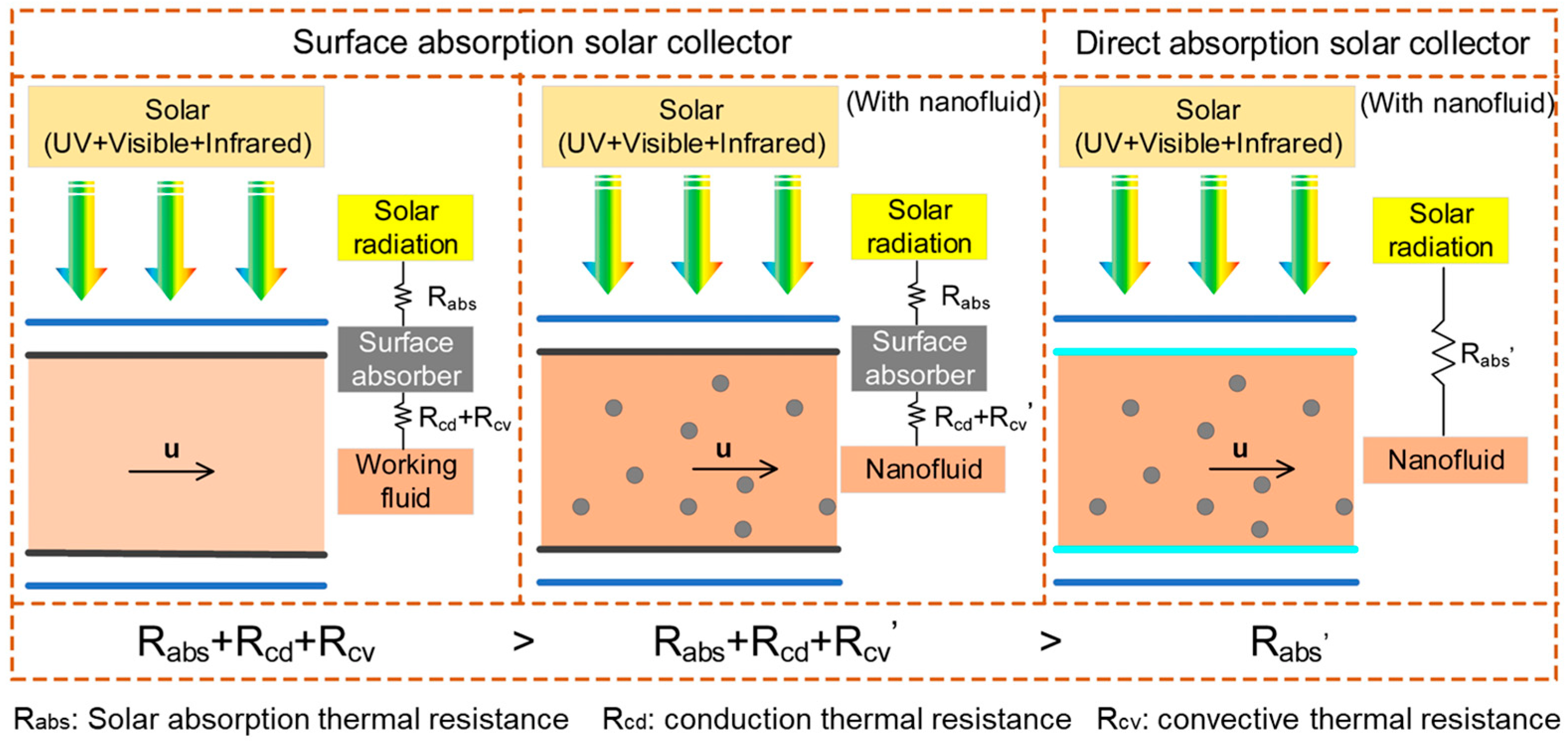

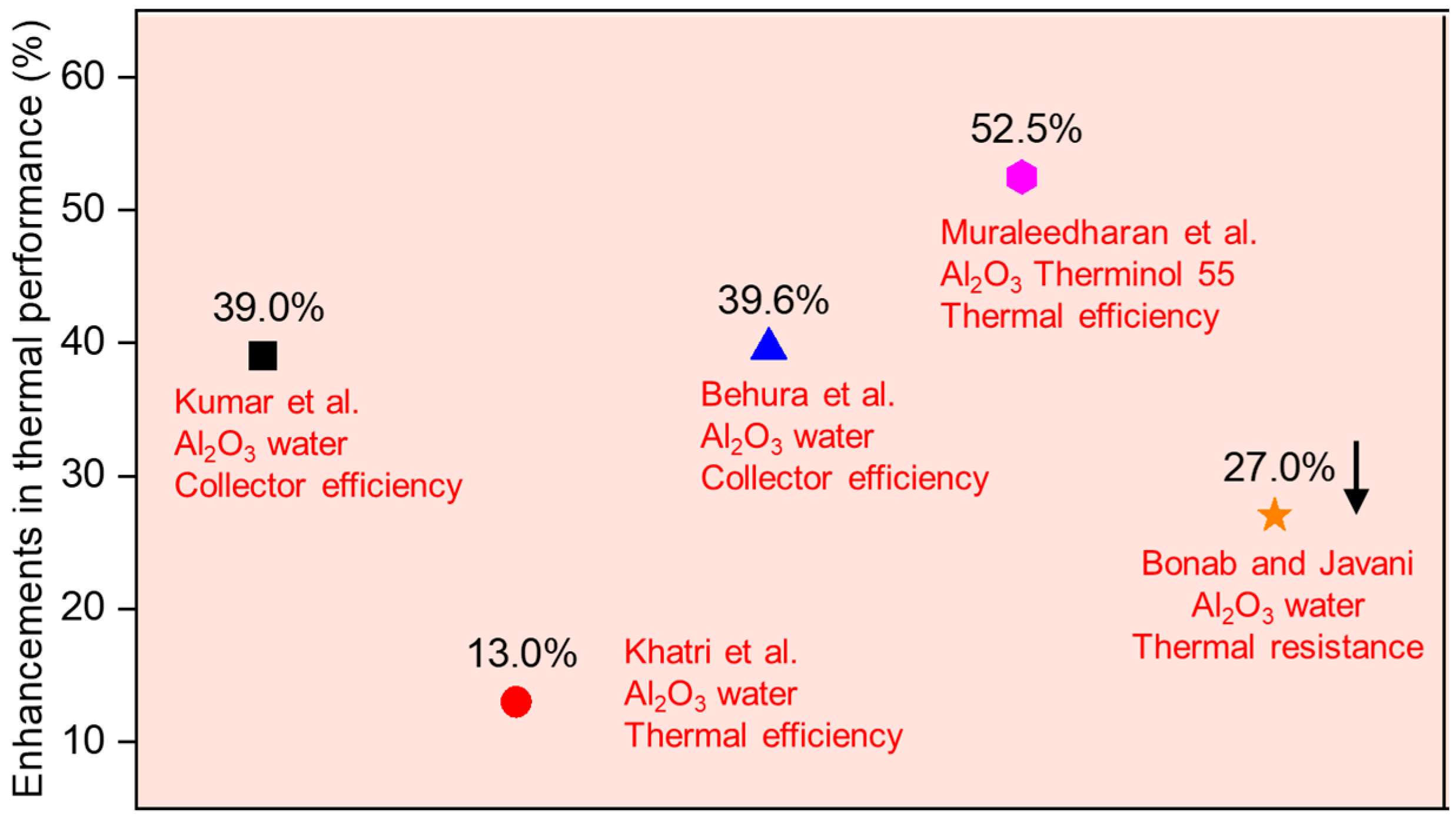
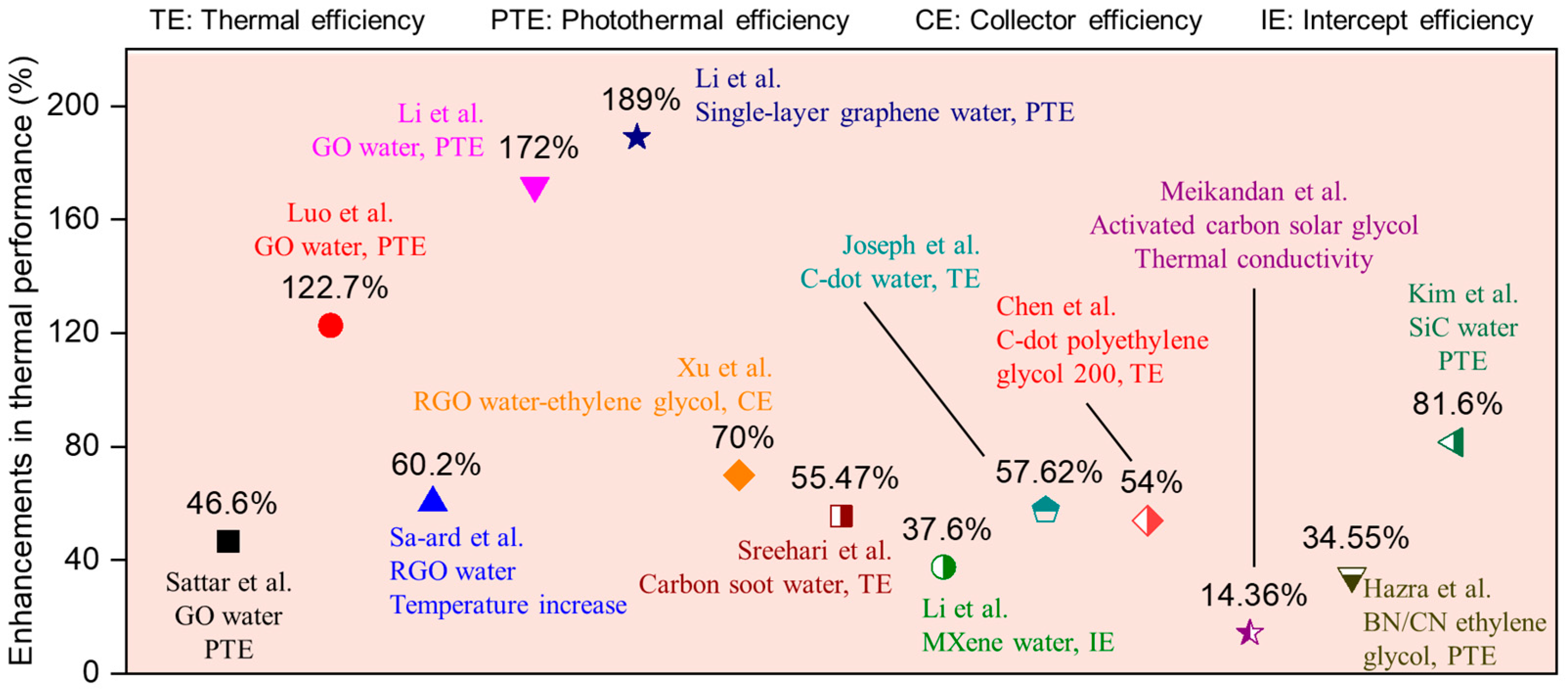
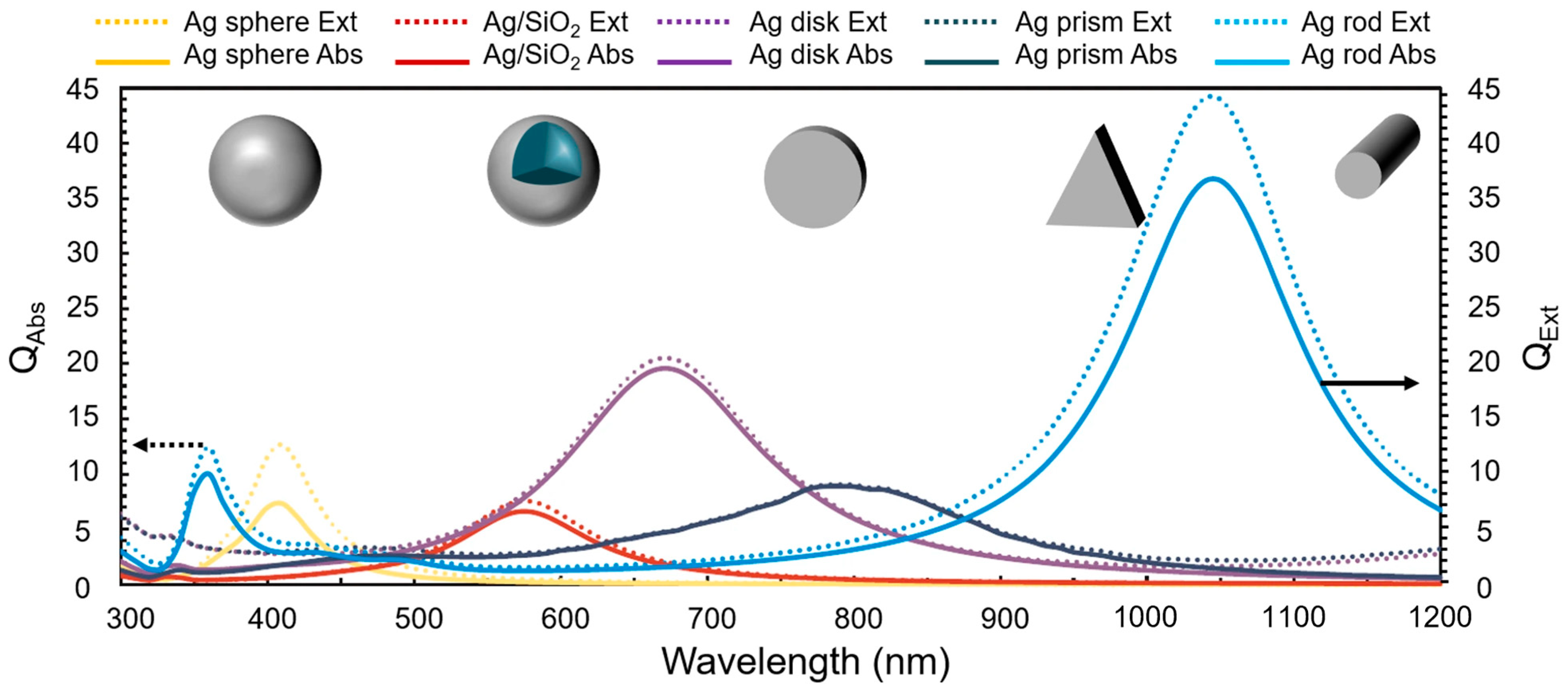

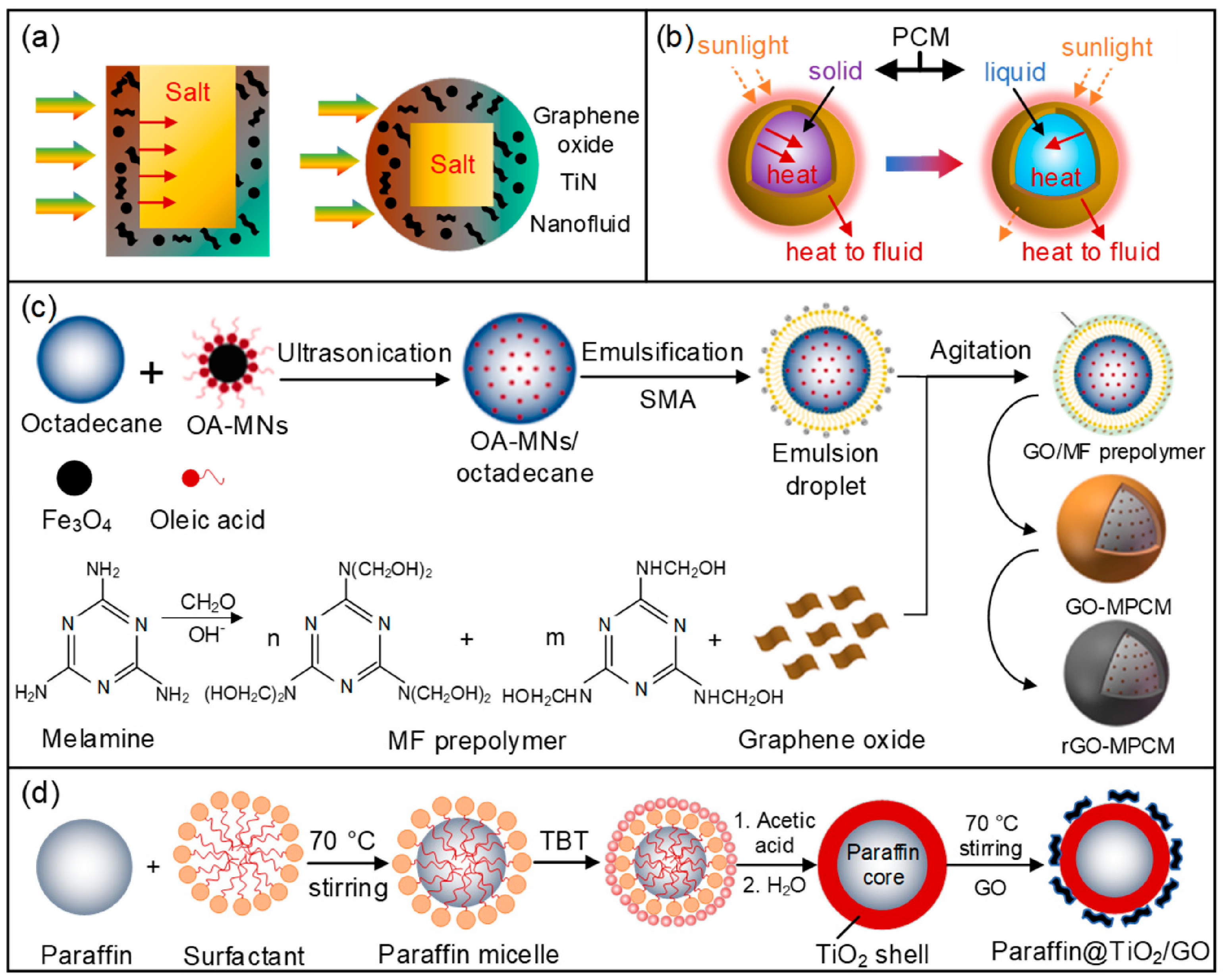
| Authors (Year) | Nanoparticle/Base Fluid | Particle Size | Remarks |
|---|---|---|---|
| Wang et al. (2019) [44] | α-Fe2O3-graphene oxide/EG | α-Fe2O3 nanorod: length of 60–500 nm; diameter of 30–80 nm | A 56.8% photothermal conversion efficiency for α-Fe2O3-graphene oxide/EG nanofluids with magnetic fields, 14.5% higher than non-external rotating magnetic field nanofluids with a 0.007 wt% RGO |
| Sreehari et al. (2020) [34] | Carbon soot/water | 50 nm | A 50% thermal efficiency for carbon soot nanofluid; 70% of the incident energy absorption for carbon soot nanofluid |
| Li et al. (2020) [45] | SiC-MWCNTs/EG | MWCNTs: length of ~30 um; SiC: 40 nm | 99.9% solar energy absorption for 0.5 wt% SiC-MWCNTs nanofluids at 1 cm path length; 97.3% solar-thermal conversion efficiency for 1 wt% SiC-MWCNTs nanofluid at 10 min, 48.6% higher than that of pure EG |
| Huang et al. (2020) [46] | Hydroxylated graphene/EG-water | Number of layers of less than 10; Thickness of 0.55–3.74 μm; diameter of 0.5–3 μm | A 73.5% instantaneous heat collection efficiency for 0.007 wt% graphene nanofluid at 30 °C, 42.22% higher than the base liquid |
| Mashhadian et al. (2021) [42] | Al2O3, MWCNTs/water | MWCNTs: length 5–10 μm; diameter 20–30 nm; Al2O3: 40 nm | A 197.1% increase in thermal efficiency of the solar collector by using hybrid nanofluids compared to water |
| Struchalin et al. (2021) [8] | MWCNTs/water-ethanol | Inner diameter 13.3 ± 0.45 nm; external diameter 49.3 ± 0.45 nm or 72.0 ± 0.45 nm; maximum length 5 μm | An increase of 5.8–37.9% in the efficiency of the solar collector for 0.01 wt% MWCNTs nanofluid relative to an equivalent geometry with surface absorption |
| Hazra et al. (2021) [38] | Boron nitride (BN)-carbon black (CN)/ethylene glycol (EG) | 70 nm | An absorbed energy fraction of 98.92% for 90 ppm/15 ppm BN/CB nanofluid; An enhancement of 34.55% photo-thermal conversion efficiency for 90 ppm/15 ppm BN/CB nanofluid after a 1200 s exposure to 437 W/m2 incident irradiance |
| Nanofluid Type | Enhanced Thermal Efficiency | Stability | Costs | Toxicity | Suggested Concentration |
|---|---|---|---|---|---|
| Oxide nanomaterial-based nanofluid | 13–75% | Low to moderate | Moderate | Low | 0.5–2.0 wt.% |
| Carbon/Nitrogen nanomaterial-based nanofluid | 14–189% | High | Low | Low | 0.01–1.0 wt.% |
| Plasmonic nanofluid | 20–240% | High | High | Moderate | 0.01–1.0 wt.% |
| Nanophase change slurry | 20–40% | High | Moderate | Low | 10–20 wt.% |
Disclaimer/Publisher’s Note: The statements, opinions and data contained in all publications are solely those of the individual author(s) and contributor(s) and not of MDPI and/or the editor(s). MDPI and/or the editor(s) disclaim responsibility for any injury to people or property resulting from any ideas, methods, instructions or products referred to in the content. |
© 2025 by the authors. Licensee MDPI, Basel, Switzerland. This article is an open access article distributed under the terms and conditions of the Creative Commons Attribution (CC BY) license (https://creativecommons.org/licenses/by/4.0/).
Share and Cite
Zhang, Z.; Liang, X.; Zheng, D.; Wang, J.; Yin, C. Advances in Enhancing the Photothermal Performance of Nanofluid-Based Direct Absorption Solar Collectors. Nanomaterials 2025, 15, 1428. https://doi.org/10.3390/nano15181428
Zhang Z, Liang X, Zheng D, Wang J, Yin C. Advances in Enhancing the Photothermal Performance of Nanofluid-Based Direct Absorption Solar Collectors. Nanomaterials. 2025; 15(18):1428. https://doi.org/10.3390/nano15181428
Chicago/Turabian StyleZhang, Zenghui, Xuan Liang, Dan Zheng, Jin Wang, and Chungen Yin. 2025. "Advances in Enhancing the Photothermal Performance of Nanofluid-Based Direct Absorption Solar Collectors" Nanomaterials 15, no. 18: 1428. https://doi.org/10.3390/nano15181428
APA StyleZhang, Z., Liang, X., Zheng, D., Wang, J., & Yin, C. (2025). Advances in Enhancing the Photothermal Performance of Nanofluid-Based Direct Absorption Solar Collectors. Nanomaterials, 15(18), 1428. https://doi.org/10.3390/nano15181428









